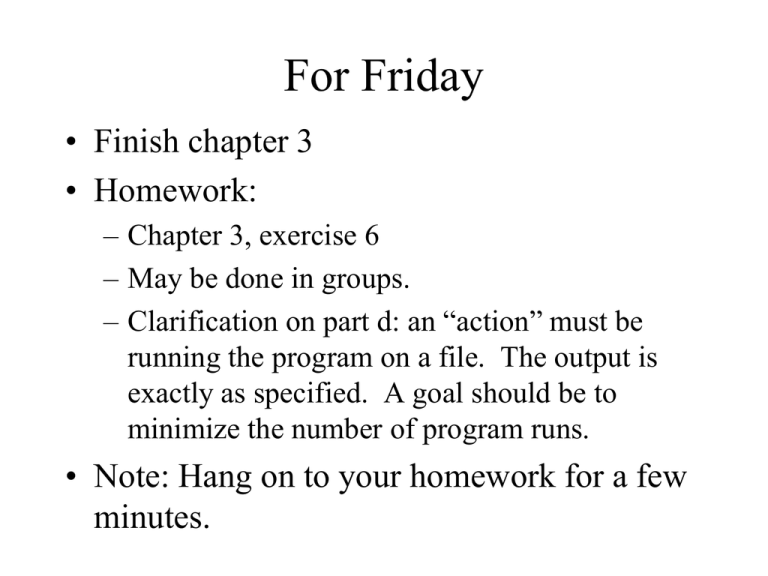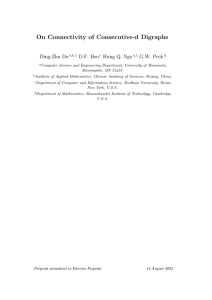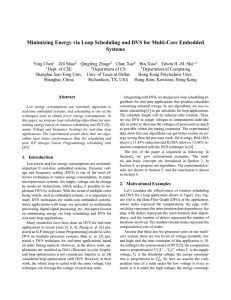Introduction to Artificial Intelligence
advertisement

For Friday • Finish chapter 3 • Homework: – Chapter 3, exercise 6 – May be done in groups. – Clarification on part d: an “action” must be running the program on a file. The output is exactly as specified. A goal should be to minimize the number of program runs. • Note: Hang on to your homework for a few minutes. Types of Agents • • • • Simple Reflex Model-based Reflex Goal-based Utility-based • Learning Homework • • • • • • • • Playing soccer Exploring the subsurface oceans of Titan Shopping for used AI books on the internet Playing a tennis match Practicing tennis against a wall Performing a high jump Knitting a sweater Bidding on an item in an auction Pathfinding Solving Problems • Getting from the current state of the world to the state we want the world to be in. • May or may not matter how we get there. Problem Formulation • • • • • • States Initial state Actions Transition model Goal test Path cost Toy Problems • • • • • 8-puzzle N-queens Peg puzzle Farmer, wolf, goat and cabbage Missionaries and cannibals More Realistic Problems • • • • • Route finding Traveling Salesman Problem VLSI layout Robot navigation Automatic assembly sequencing Searching Concepts • A state can be expanded by generating all states that can be reached by applying a legal operator to the state • State space can also be defined by a successor function that returns all states produced by applying a single legal operator • A search tree is generated by generating search nodes by successively expanding states starting from the initial state as the root Search Node Contents • May include – – – – – Corresponding state Parent node Operator applied to reach this node Length of path from root to node (depth) Path cost of path from initial state to node General Search Function function General-Search(problem, strategy) returns a solution, or failure initialize the search tree using the initial state of problem loop do if there are no candidates for expansion then return failure choose a leaf node for expansion according to strategy if the node contains a goal state then return the corresponding solution else expand the node and add the resulting nodes to the search tree end loop end Implementing Search Algorithms • Maintain a list of unexpanded search nodes • By using different strategies for ordering the list of search nodes, we implement different searching strategies • Eg. breadth-first search is implemented using a queue and depth-first using a stack (as we’ll see soon) Search Function Revisited function General-Search(problem, Queuing-Fn) returns a solution, or failure nodes <- MakeQueue(Make-Node(Initial-State(problem))) loop do if nodes is empty then return failure node <- Remove-Front(nodes) if Goal-Test(problem) applied to State(node) succeeds then return the corresponding solution else nodes <- Queuing-Fn(nodes, Expand(node, Operators(problem))) end loop end Properties of Search Strategies • • • • Completeness Time Complexity Space Complexity Optimality Two Types of Search • Uninformed Search – Also called blind, exhaustive or brute-force – Make use of no information about the problem – May be quite inefficient • Informed Search – Also called heuristic or intelligent – Uses information about the problem to guide the search – Usually guesses the distance to a goal state – Not always possible Breadth-First Search • List ordering is a queue • All nodes at a particular depth are expanded before any below them • How does BFS perform? – Completeness – Optimality Complexity of BFS • Branching Factor • For branching factor b and solution at depth d in the tree (i.e. the path-length of the solution is d) – Time required is: 1 + b + b2 + b3 + … bd – Space required is at least bd • May be highly impractical • Note that ALL of the uninformed search strategies require exponential time Uniform Cost Search • Similar to breadth first, but takes path cost into account Depth First Search • How does depth first search operate? • How would we implement it? • Performance: – – – – Completeness Optimality Space Complexity Time Complexity Comparing DFS and BFS • When might we prefer DFS? • When might we prefer BFS?







